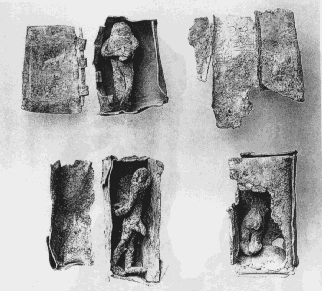I will turn now to the construction of Kolossoi. They may be made of metal (e.g. bronze, wood, silver or lead; the latter being the most common metal), wood, clay, wax or similar malleable materials. The image is not normally realistic, since it does not depend on similarity of appearance to become connected with its Subject; that is accomplished by other means (described below). Typically the figure is nude, and often there is exaggeration of the genitals, feet or other parts; this accords with the general principle of using shocking or obscene images to ward off the evil eye and other dangers (e.g., the sign of the fig and phallic amulets).
Generally some parts of the figure are twisted backward, to indicate the incapacitation of the Subject. Often the head is twisted backward, or at least extremely far to the left, to cause confusion. It is also common for the feet to be backward, and sometimes the arms or the entire torso. (So Hephaistos is sometimes shown with His feet backward.) In some cases the Kolossos is made with these parts backward, but usually they are made normally and then twisted around.
The figure is often pierced with nails or needles (13 is a popular number), typically made of iron or bronze, though animal fangs and other materials may be used. Each nail or needle transfixes some part of the body representing a faculty, which it thereby paralyzes, but without destroying it. For example, nails through the eyes, ears and mouth paralyze cognitive faculties, while one through the heart might restrain will, and nails through the limbs cause paralysis or loss of strength.
The Kolossos may be further mutilated to restrain the enemy; for example the head may be hacked off and buried separately from the body (to prevent them being rejoined), or the effigy may be burned, melted, crushed, trampled under foot, etc. (These aggressive measures are not normally used for laying ghosts; instead the Kolossos is given funeral rites. A ghost is normally called by name for three days or thrice in one day to summon it home for burial.)
In addition to being transfixed, the figure is normally bound. For example, the arms may be bound (usually behind the back), the legs may be bound, and sometimes the arms are bound to the legs. There may be a collar around the neck, or a binding around the mouth (which could hold a nail or peg in it). Sometimes the Kolossos is bound to another object, such as an erotic amulet.
A number of materials may be used for binding, including lead bands, bronze wires, nails and iron chains (for large Kolossoi). The figure may even bind itself, for example with the right hand over its mouth (perhaps holding in a nail) and the left over its anus.
The Kolossos is identified with its Subject by either incantation or inscription, most often by both. The Subject (deity, ghost, person) is mentioned by name if its name is known, often including a patronymic or mentioning the Subject's mother, e.g., "NN whom NN bore" ("NN" stands for a name). The Subject's name is usually inscribed on the left side of the Kolossos, most often on the hip, leg or arm; the name may also be written in red ink. The name is often accompanied with a binding formula (See next article).
(c) 1996, Apollonius Sophistes
Tags: making athame tool wrappings temple construction opinions experience wands witch misc tools consecrating method tools craft workbook exercises pocket spell your wiccan supplies witch books your fingertips line called alchemy single







